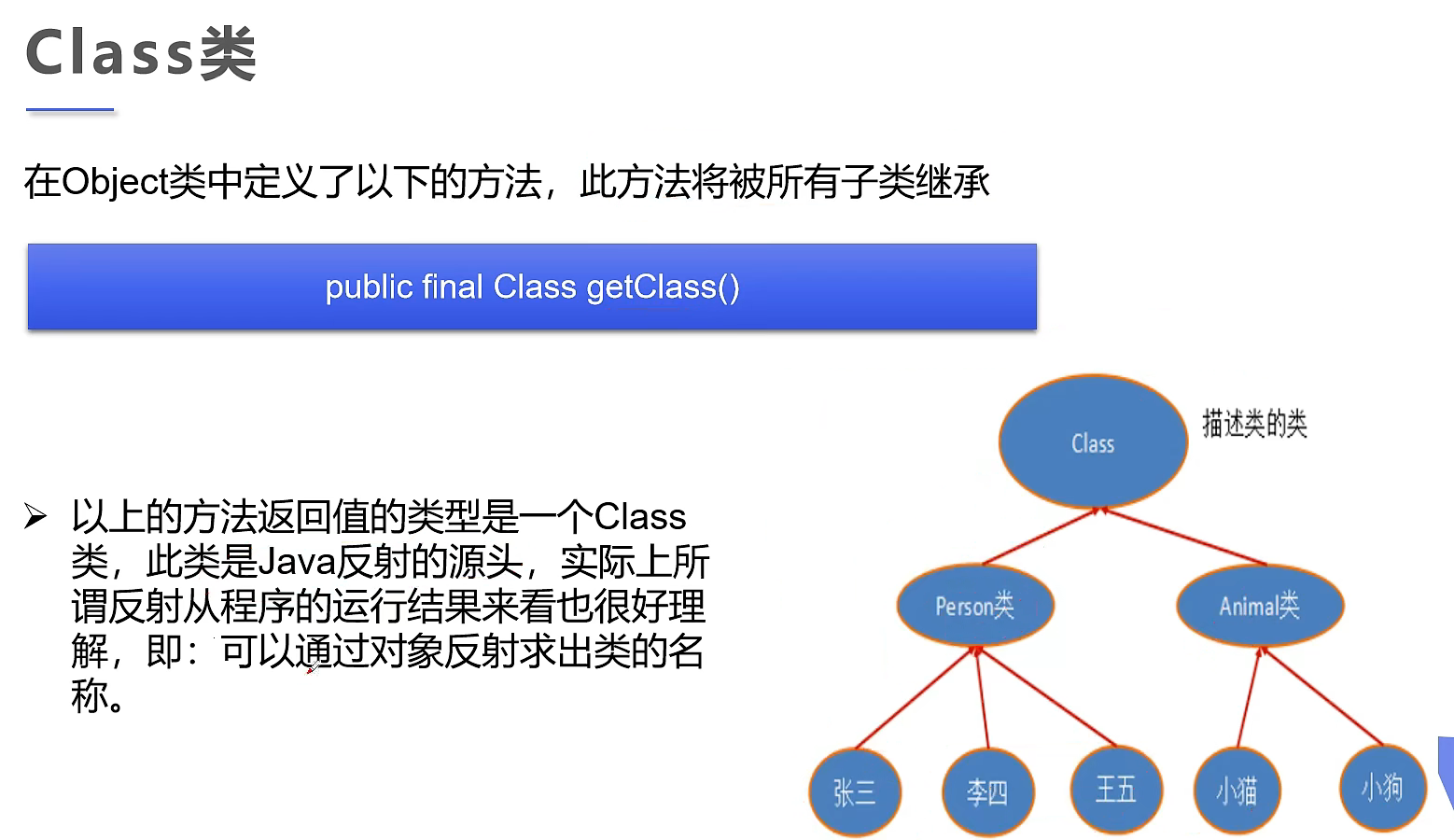注解和反射
注解
注解:Annotation 从JDK5.0开始引入的新技术
-
Annotation的作用:
-
不是程序本身,它可以对程序做出解释(这一点和注释(comment)没什么区别)
-
可以被其他程序(比如:编辑器等)读取
-
-
Annotation的格式: 以“@注释名”在代码中存在的,还可以添加一些参数值,比如:@SuppressWarnings(value="unchecked")
-
Annotation在哪里使用? 可以附加在package、class、method、field等上面,相当于给它们添加了额外的辅助信息,我们可以通过反射机制编程实现对这些元数据的访问
内置注解
-
@Override : 定义在java.lang.Override中,此注解只适用于修饰方法,表示一个方法声明打算重写超类中的另一个方法的声明
-
@Deprecated: 定义在java.lang.Deprecated中,此注解可以用于修饰方法、属性、类,表示不鼓励程序员使用这样的元素,通常是因为它很危险,或者有更好的选择 (能用 只是不建议使用)
-
@SuppressWarnings: 定义在java.lang.SuppressWarnings中,用来抑制编译时的警告信息,它与前两个注释有所不同,需要添加一个参数才能正常使用,这些参数都是定义好了的,我们选择性的使用就好
-
@SuppressWarnings("all")
-
@SuppressWarnings("unchecked")
-
@SuppressWarnings(value={"unchecked","deprecation"})
-
元注解
元注解的作用就是负责注解其他注解,Java定义了4个标准的meta-annotation类型,他们被用来提供对其他annotation类型做说明
这些类型和它们所支持的类在java.lang.annotation包中可以找到
-
@Target : 用于描述注解的使用范围(即:被描述的注解可以用在什么地方)
-
@Retention : 表示需要在什么级别保存该注释信息,用于描述注解的生命周期(范围:RUNTIME > CLASS > SOURCE)
-
@Document : 说明该注释被包含在javadoc中
-
@Inherited : 说明子类可以继承父类中的该注解
package com.annotation_reflection.annotation;
import java.lang.annotation.*;
//测试元注解
public class Demo02 {
}
//定义一个注解
自定义注解
使用@Interface自定义注解时,自动继承了java.long.Annotation接口
分析:
-
@Interface用来声明一个注解,格式:public @Interface 注解名 {定义内容}
-
其中的每一个方法实际上是声明了一个配置参数
-
方法的名称就是参数的名称
-
返回值类型就是参数的类型(返回值只能是基本类型、Class、String、enum)
-
可以通过default来声明参数的默认值
-
如果只有一个参数成员,一般参数名为value
-
注解元素必须要有值,我们定义注解元素时,经常使用空字符串、0作为默认值
package com.annotation_reflection.annotation;
import java.lang.annotation.ElementType;
import java.lang.annotation.Retention;
import java.lang.annotation.RetentionPolicy;
import java.lang.annotation.Target;
//自定义注解
反射
反射:Reflection
反射(Reflection)是Java被视为动态语言的关键,反射机制允许程序在执行期间借助于Reflection API取得任何类的内部信息,并能直接操作任意对象的内部属性及方法。
Class c= Class.forName("java.lang.String")
加载完类之后,在堆内存的方法区中就产生了一个Class类型的对象(一个类只有一个class对象),这个对象就包含了完整的类的结构对象。我们可以通过这个对象看到类的结构。这个对象就像一面镜子,透过镜子看到类的结构,所以我们形象的称之为:反射
正常方式:
引入需要的“包类”名称——>通过new实例化——>取得实例化对象
反射方式:
实例化对象——>getClass()方法——>得到完整的“包类”名称
补充:
静态语言VS动态语言
动态语言:是一类在运行时可以改变其结构的语言:例如新的函数、对象、甚至代码可以被引进,已有的函数可以被删除或是其它结构上的变化。通俗点说就是在运行时代码可以根据某些条件改变自身结构
主要的动态语言:Object-C、C#、JavaScript、PHP、python等
静态语言:与动态语言相对应的,运行时结构不可变的语言就是静态语言。如Java、C、C++
Java不是动态语言,但Java可以被成为“准动态语言”。即Java有一定的动态性,我们可以利用反射机制获得类似动态语言的特性。Java的动态性让编程更加灵活
Java反射机制提供的功能:
-
在运行时判断任意一个对象所属的类
-
在运行时构造任意一个类的对象
-
在运行时判断任意一个类型所具有的成员变量和方法
-
在运行时获取泛型信息
-
在运行时调用任意一个对象的成员变量和方法
-
在运行时处理注解
-
生成动态代理
-
...........................
Java反射的优点和缺点:
优点:可以实现动态创建对象和编译,体现出很大的灵活性
缺点:对性能有影响。使用反射基本上是一种解释操作,我们可以告诉JVM,我们希望做什么并且它满足我们的要求。这类操作总是慢于直接执行相同的操作。
反射相关的主要API:
-
java.lang.Class :代表一个类
-
java.lang.reflect.Method :代表类的方法
-
java.lang.reflect.Field :代表类的成员变量
-
java.lang.reflect.Constructor :代表类的构造器
-
..................
Class类

对象照镜子后可以得到的信息:某个类的属性、方法和构造器、某个类到底实现了哪个接口。对于每个类而言,JRE都为其保留一个不变的Class类型的对象。一个Class对象包含了特定某个结构(class\interface\enum\annotation\primitive type\void[])的有关信息。
-
Class本身也是一个类
-
Class对象只能由系统建立对象
-
一个加载的类在JVM中只会有一个Class实例
-
一个Class对象对应的是一个加载到JVM中的一个class文件
-
每个类的实例都会记得自己是由哪个Class实例所生成
-
通过Class可以完整地得到一个类中的所有被加载的结构
-
Class类是Reflection的根源,针对任何你想动态加载、运行的类,唯有先获得相应的Class对象

获得Class类的实例的几种方式:
-
若已知具体的类,通过类的class属性获取,该方法最为安全可靠,程序性能最高:
Class c = Person.class; -
已知某个类的实例,调用该实例的getClass()方法获取Class对象:
Class c = person.getClass; -
已知一个类的全类名,且该类在类路径下,可通过Class类的静态方法forName()获取,要抛出“ClassNotFoundException”
Class c = Class.forName("demo01.Student"); -
内置基本数据类型可以直接用类名,Type
-
还可以利用ClassLoader
package com.annotation_reflection.reflection;
//测试创建Class类的方式有哪些
public class Demo02 {
public static void main(String[] args) {
Person person = new Student();
System.out.println(person.name);
//方式1:已知具体的类,通过类的class属性获取
Class s1 = Student.class;
System.out.println(s1.hashCode());
//方式2:已知某个类的实例,调用该实例的getClass()方法获取
Class s2 = person.getClass();
System.out.println(s2.hashCode());
//方式3:已知一个类的全类名,且该类在类路径下,通过Class类的静态方法forName()获取
try {
Class s3 = Class.forName("com.annotation_reflection.reflection.Student");
System.out.println(s3.hashCode());
} catch (ClassNotFoundException e) {
e.printStackTrace();
}
//测试返回当前Class对象的父类的Class对象
Class s1Super = s1.getSuperclass();
System.out.println(s1Super.getName());
}
}
class Person{
public String name;
public Person() {
}
public Person(String name) {
this.name = name;
}
哪些类型可以有Class对象:
-
class:外部类,成员(成员内部类、静态内部类),局部内部类、匿名内部类
-
interface : 接口
-
[] : 数组
-
enum:枚举
-
annotation:注解@interface
-
primitive type :基本数据类型
-
void
package com.annotation_reflection.reflection;
import java.lang.annotation.ElementType;
public class Demo03 {
public static void main(String[] args) {
Class c1 = Object.class; //类
Class c2 = Comparable.class; //接口
Class c3 = String[].class; //一维数组
Class c4 = String[][].class; //二维数组
Class c5 = ElementType.class; //枚举
Class c6 = Override.class; //注解
Class c7 = int.class; //基本数据类型
Class c8 = void.class; //void
Class c9 = Class.class; //Class本身
//快捷键 复制本行到下一行 :ctrl+d 一列复制:按住alt控制鼠标
System.out.println(c1);
System.out.println(c2);
System.out.println(c3);
System.out.println(c4);
System.out.println(c5);
System.out.println(c6);
System.out.println(c7);
System.out.println(c8);
System.out.println(c9);
//只要元素类型与维度一样,就是同一个class
int[] a = new int[10];
int[] b = new int[100];
int[][] c = new int[10][10];
Class a1 = a.getClass();
Class b1 = b.getClass();
Class c11 = c.getClass();
System.out.println(a1);
System.out.println(b1);
System.out.println(c11);
}
}
/* 输出结果
class java.lang.Object
interface java.lang.Comparable
class [Ljava.lang.String;
class [[Ljava.lang.String;
class java.lang.annotation.ElementType
interface java.lang.Override
int
void
class java.lang.Class
class [I
class [I
class [[I
*/
类加载内存分析
Java内存:
-
堆 :存放new的对象和数组、可以被所有的线程共享,不会存放别的对象引用
-
栈:存放基本数据类型(会包含这个基本数据类型的具体数值)、引用对象的变量(会存放这个引用在堆里面的具体地址)
-
方法区:可以被所有的线程共享、包含了所有的class和static变量
了解类的加载过程:
当程序主动使用某个类时,如果该类还未被加载到内存中,则系统会通过以下三个步骤来对该类进行初始化:
-
类的加载(Load):将类的class文件读入内存,并为之创建一个java.lang.Class对象。此过程由类加载器完成
-
类的链接(Link):将类的二进制数据合并到JRE中
-
类的初始化(Initialize):JVM负责对类进行初始化

分析类初始化
类的主动引用(一定会发生类的初始化):
-
当虚拟机启动,先初始main方法所在的类
-
new 一个类的对象
-
调用类的静态成员(除了final常量)和静态方法
-
使用java.lang.reflect包的方法对类进行反射调用
-
当初始化一个类,如果其父类没有被初始化,则会先初始化它的父类
类的被动引用(不会发生类的初始化):
-
当访问一个静态域时,只有真正声明这个域的类才会被初始化。如:当通过子类引用父类的静态变量,不会导致子类被初始化
-
通过数组定义类引用,不会触发此类的初始化
-
引用常量不会触发此类的初始化(常量在链接阶段就存入调用类的常量池中了)
package com.annotation_reflection.reflection;
public class Demo04 {
static {
System.out.println("main所在的类被初始化");
}
public static void main(String[] args) throws ClassNotFoundException {
// 1. new 主动引用
//Zi zi = new Zi();
//2.调用类的静态成员 主动引用
//System.out.println(Zi.m);
//3.反射调用 主动引用
//Class.forName("com.annotation_reflection.reflection.Zi");
//不会产生类的引用的方法
//System.out.println(Zi.b);
//System.out.println(Zi.n);
}
}
class Fu{
static int b=2;
static {
System.out.println("父类被初始化");
}
}
class Zi extends Fu{
static {
System.out.println("子类被初始化");
m=300;
}
static int m=100;
static final int n=10;
}
类加载器
类加载器的作用:将class文件字节码内容加载到内存中,并将这些静态数据转换成方法区的运行时数据结构,然后在堆中生成一个代表这个类的java.lang.Class对象,作为方法区中类数据的访问入口。
类缓存:标准的JavaSE类加载器可以按照要求查找类,但一旦某个类被加载到类加载器中,它将维持加载(缓存)一段时间。不过JVM垃圾回收机制可以回收这些Class对象。


package com.annotation_reflection.reflection;
//测试类加载器
public class Demo05 {
public static void main(String[] args) throws ClassNotFoundException {
//获取系统类的加载器
ClassLoader systemClassLoader = ClassLoader.getSystemClassLoader();
System.out.println(systemClassLoader);
//获取系统类加载器的父类-->扩展类加载器
ClassLoader parent = systemClassLoader.getParent();
System.out.println(parent);
//获取扩展类加载器的父类-->根加载器(c/c++) 无法获取
ClassLoader parent1 = parent.getParent();
System.out.println(parent1);
System.out.println("------------------------");
//测试当前类是哪个类加载器加载的
ClassLoader classLoader = Class.forName("com.annotation_reflection.reflection.Demo05").getClassLoader();
System.out.println(classLoader); //系统加载器
ClassLoader classLoader1 = Class.forName("java.lang.String").getClassLoader();
System.out.println(classLoader1); //根加载器
}
}
/*
jdk.internal.loader.ClassLoaders$AppClassLoader@6d06d69c
jdk.internal.loader.ClassLoaders$PlatformClassLoader@7adf9f5f
null
------------------------
jdk.internal.loader.ClassLoaders$AppClassLoader@6d06d69c
null
*/
获取运行时类的完整结构
通过反射获取运行时类的完整结构:Field、Method、Constructor、Superclass、Interface、Annotation
-
实现的全部接口
-
所继承的父类
-
全部的构造器
-
全部的方法
-
全部的Filed
-
注解
-
.............
package com.annotation_reflection.reflection;
import java.lang.reflect.Constructor;
import java.lang.reflect.Field;
import java.lang.reflect.Method;
public class Demo06 {
public static void main(String[] args) throws ClassNotFoundException, NoSuchFieldException {
Class c1 = Class.forName("com.annotation_reflection.reflection.User");
//获得类的名字
System.out.println(c1.getName()); //包名+类名
System.out.println(c1.getSimpleName()); //类名
System.out.println("------------------");
//获得其父类
System.out.println(c1.getSuperclass());
System.out.println("------------------");
//获得类的属性
Field[] fields = c1.getFields(); //只能获得public属性
for (Field field : fields) {
System.out.println(field);
}
System.out.println("------------------");
Field[] declaredFields = c1.getDeclaredFields(); //获得全部属性
for (Field declaredField : declaredFields) {
System.out.println(declaredField);
}
System.out.println("------------------");
Field name = c1.getDeclaredField("name");
System.out.println(name);
System.out.println("------------------");
//获得类的方法
Method[] declaredMethods = c1.getDeclaredMethods();
for (Method declaredMethod : declaredMethods) {
System.out.println(declaredMethod);
}
System.out.println("------------------");
//获得指定的构造器
Constructor[] constructors = c1.getConstructors();
for (Constructor constructor : constructors) {
System.out.println(constructor);
}
Constructor[] declaredConstructors = c1.getDeclaredConstructors();
for (Constructor declaredConstructor : declaredConstructors) {
System.out.println(declaredConstructor);
}
}
}
/*
com.annotation_reflection.reflection.User
User
------------------
class java.lang.Object
------------------
------------------
private int com.annotation_reflection.reflection.User.id
private int com.annotation_reflection.reflection.User.age
private java.lang.String com.annotation_reflection.reflection.User.name
------------------
private java.lang.String com.annotation_reflection.reflection.User.name


